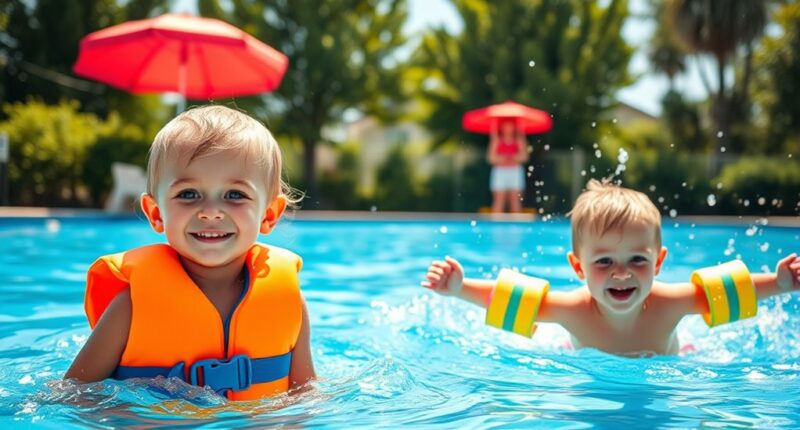To guarantee safe summer fun for kids around water, always supervise them without distractions—designate a “water watcher” who’s committed to keeping an eye on them. Install proper safety measures like isolation fences for pools and use U.S. Coast Guard-approved life jackets. Start swimming lessons early to build confidence and skills. Educate your children on water safety rules and have a plan for emergencies. Want to know more about making your summer safe and enjoyable?
Key Takeaways
- Always supervise children near water, designating a “water watcher” to eliminate distractions and maintain constant vigilance.
- Enforce safety measures like a four-sided fence around pools and use pool alarms for added protection.
- Begin swimming lessons early, ideally around age 1, to enhance water safety skills and confidence.
- Ensure children wear U.S. Coast Guard-approved life jackets that fit properly, especially during water activities.
- Educate kids on recognizing distress signals and responding appropriately in emergencies to promote water competence.
The Importance of Supervision Around Water
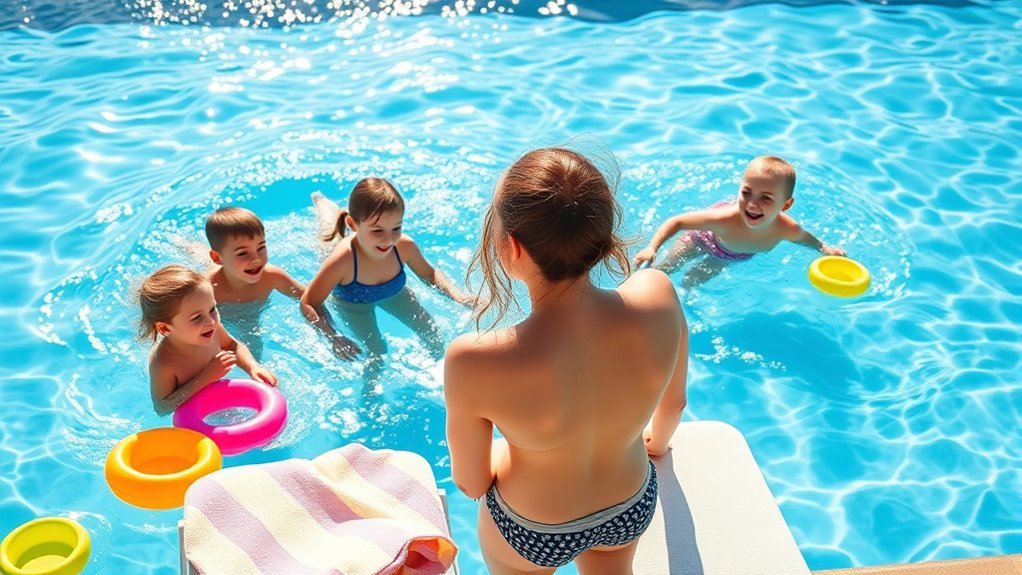
When it comes to keeping kids safe around water, constant supervision is essential. Drowning is a leading cause of death for younger children, so you need to be vigilant.
Always stay within arm’s reach of your child and designate a “water watcher” who can focus entirely on supervising—no phones or distractions allowed. Taking turns with other adults helps maintain alertness, preventing lapses in attention.
Keep in mind that familiarity with a home pool may lead to overconfidence, reducing your vigilance. Educating yourself on drowning risks and being aware that it can happen in minimal water will enhance your supervision.
Pool and Home Safety Measures

Supervision is only one part of ensuring kids’ safety around water; implementing effective pool and home safety measures is equally important.
Start by installing a four-sided isolation fence around your pool, complete with a self-closing, self-latching gate at least 54 inches high. Designate an official Water Watcher who’ll focus solely on supervising children without distractions. Use pool alarms to alert you if someone enters the water unexpectedly.
At home, instill a no-tolerance policy for unsupervised water play, and empty all water containers after use. Keep bathroom doors closed and install toilet lid locks to prevent accidents.
Finally, store small containers upside down and out of reach, eliminating any standing water hazards. These steps can greatly enhance water safety.
Starting Swimming Lessons Early
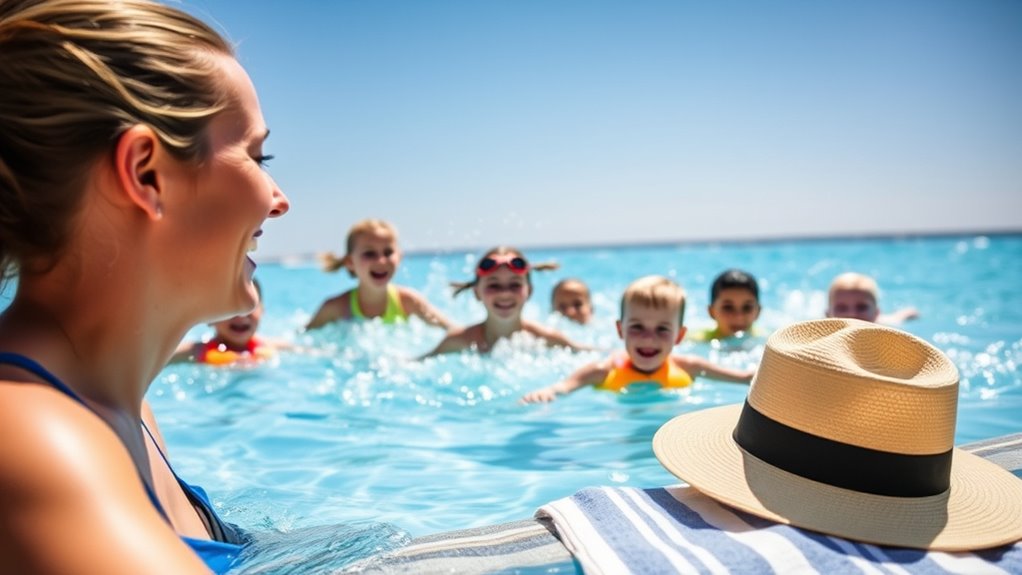
Starting swimming lessons early can greatly enhance your child’s safety and confidence in the water. Research shows that formal swimming lessons can reduce drowning risk by up to 88% for children aged 1 to 4.
Beginning lessons around age 1, or even as early as 6 months, helps children develop essential water survival skills and fosters their physical and cognitive growth. Kids learn to float, tread, and control their breathing, while also building strength and coordination.
Plus, swim classes promote social skills and bonding with instructors and peers. By enrolling your child in lessons early, you’re not just teaching them to swim; you’re instilling confidence and encouraging a lifelong love for water activities.
Understanding Life Jackets and Safety Devices
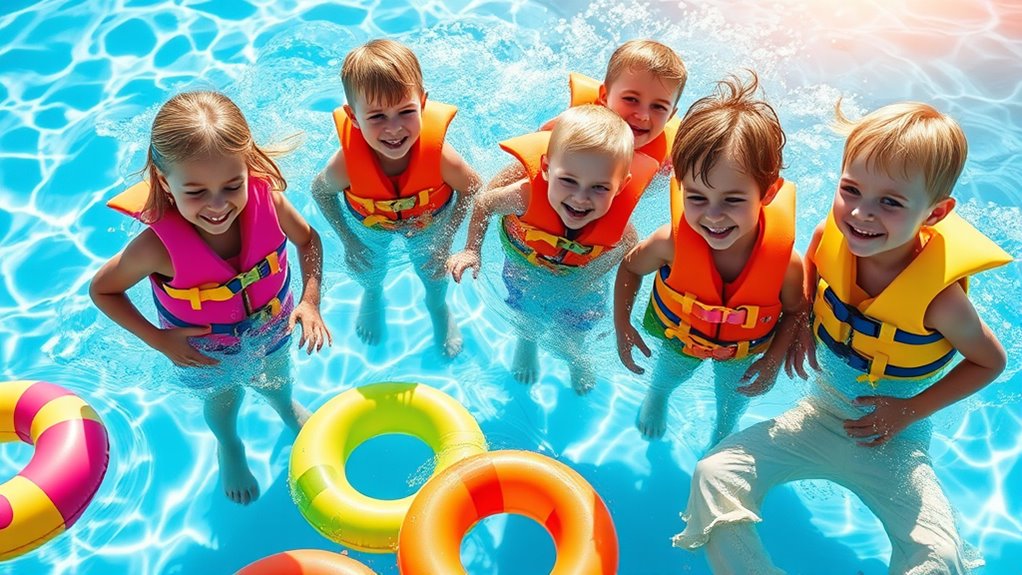
After your child has gained some swimming skills, understanding life jackets and safety devices becomes essential for their protection in the water.
Always choose U.S. Coast Guard-approved life jackets, ensuring they fit snugly without riding above your child’s ears. Select the correct size based on their weight: infants (8-30 lbs), children (30-50 lbs), and youth (50-90 lbs).
For calm water, Type II jackets offer head support, while Type III is ideal for young swimmers needing flotation. Remember, inflatable toys and puddle jumpers aren’t substitutes for life jackets.
Consistently supervise your child during water activities, and educate them about respecting water’s power. Prioritizing reliable safety devices can prevent accidents and help everyone enjoy a fun, safe summer.
Navigating Open Water Safely
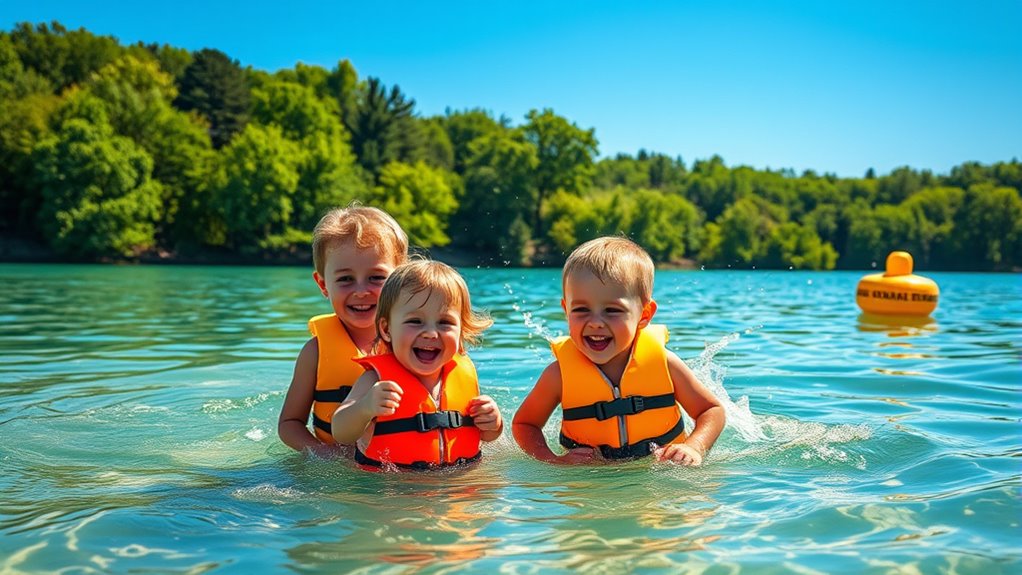
When steering through open water, staying aware of your surroundings is essential for ensuring a safe experience. Strong currents and undertows can quickly pull you under, so always check the water conditions before diving in.
Look for designated swimming zones marked by signs or buoys, and choose areas with lifeguards present whenever possible. Avoid unmarked ponds or rivers, as they often hide unseen dangers.
Keep an eye on changing weather conditions, since they can affect safety in an instant. Always supervise children closely, keeping them within arm’s reach, and teach them to respect water boundaries.
Additional Safety Measures for Families
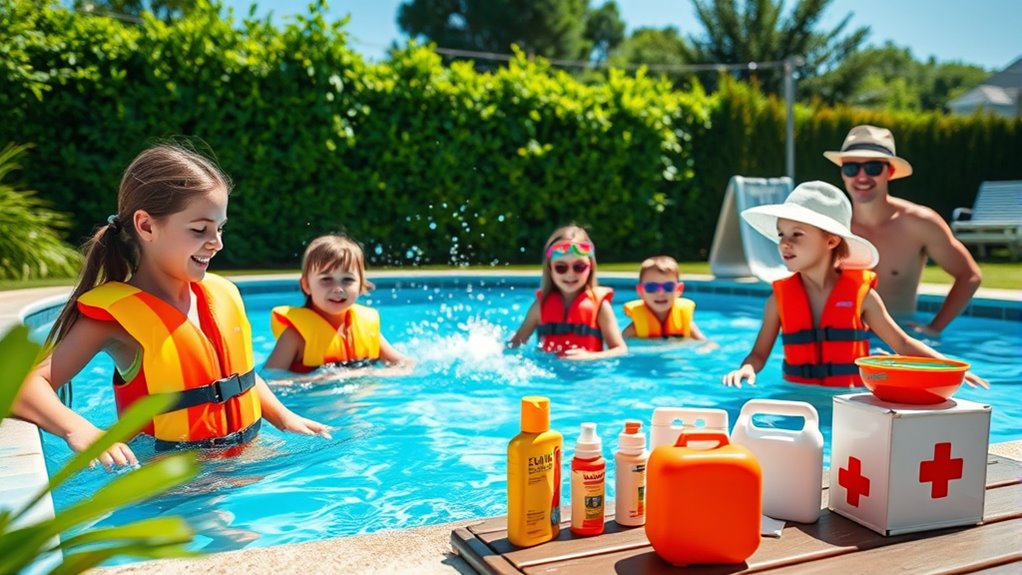
To guarantee kids stay safe around water, it’s essential to implement additional safety measures that go beyond basic supervision.
Start by installing a four-sided fence around your pool, ensuring it’s at least 4 feet high with self-latching gates. Use door alarms to alert you if kids try to access the pool area.
Installing a four-sided fence around your pool with self-latching gates is crucial for child safety.
Always empty bathtubs, sinks, and small containers after use to minimize drowning risks. Keep toilet lids closed and secured.
Designate an adult to supervise children near water at all times. Additionally, learn CPR and first aid.
Keep rescue equipment nearby, like a life preserver and a reaching pole. Have a charged phone ready for emergencies, and create a clear emergency plan everyone understands.
Regular safety drills can also help reinforce these measures.
Teaching Children Water Safety Rules
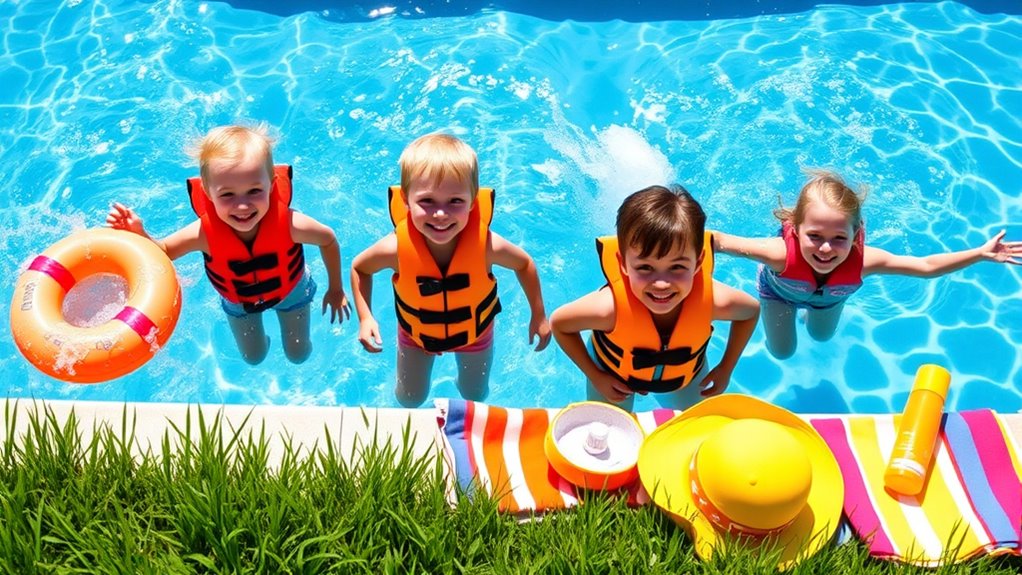
Implementing safety measures is only part of ensuring your child’s safety around water; teaching them the rules is equally important. Start with interactive storytelling that involves water scenarios, and ask predictive questions to engage them. Use props like toy boats to make the lessons fun.
Incorporate play-based learning with games about water safety and mock rescue simulations during bath time. Create colorful safety charts and involve your child in designing them for ownership. Enroll them in swim lessons to build water competency and teach essential safety strategies.
Always emphasize asking permission before entering water, adult supervision, and the importance of life jackets. Regular discussions about these rules help reinforce their importance and keep safety top of mind.
The Role of Designated Water Watchers
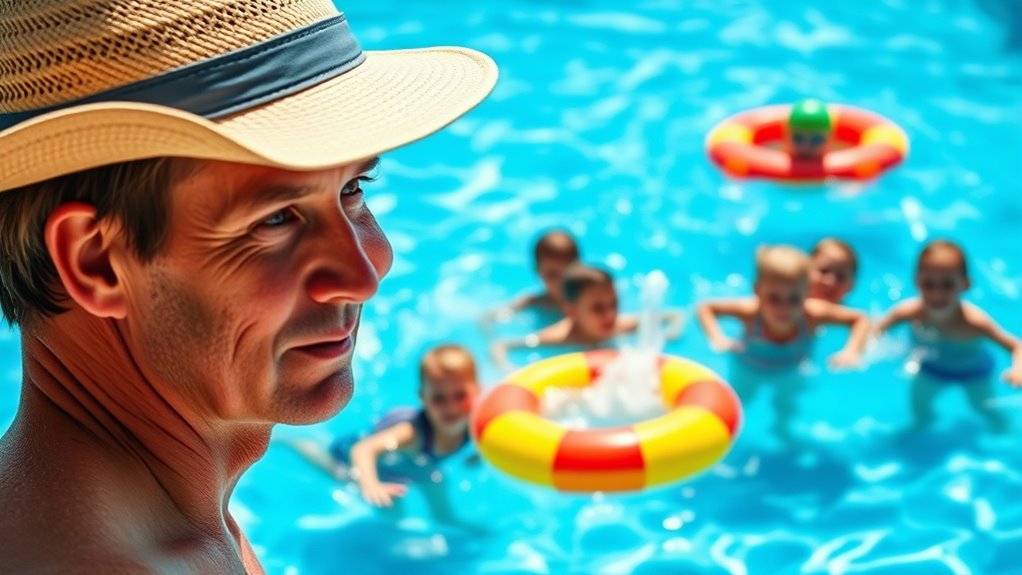
Designating Water Watchers is an important step in keeping kids safe around water. These individuals provide consistent supervision, essential because drowning can happen silently and without warning.
You’ll want a responsible adult, preferably at least 16 years old, who can recognize distress signals and knows CPR. It’s imperative that they remain undistracted—no texting or chatting—while keeping their eyes on the water.
Rotating Water Watchers every 15-20 minutes helps maintain focus and prevents fatigue. Identifying them with badges can clarify their role.
Recognizing and Responding to Emergencies
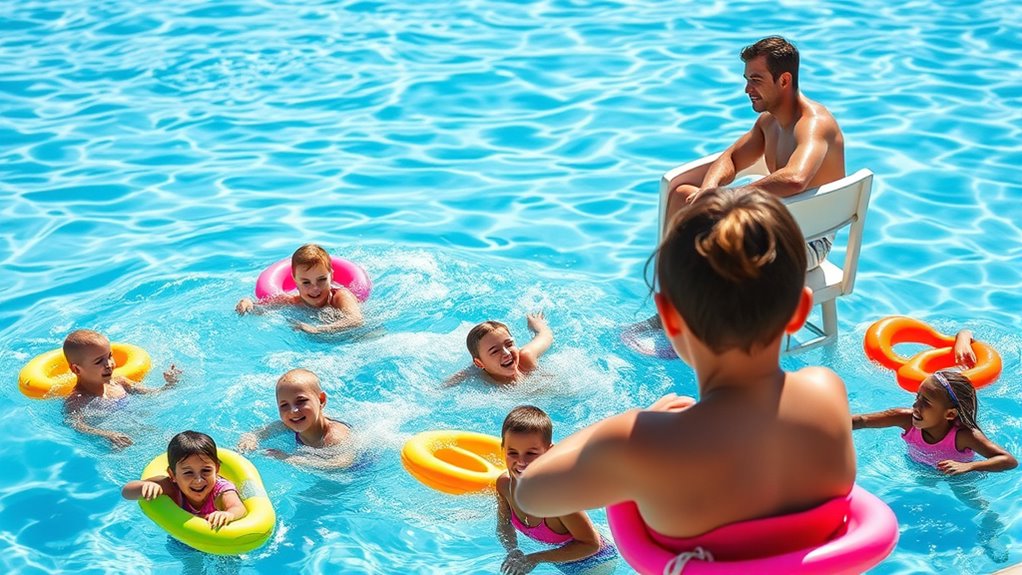
Even with vigilant Water Watchers on duty, emergencies can still arise around water. Drowning is often silent; a person may struggle without the ability to yell for help.
Watch for signs of distress: a swimmer may remain vertical but unable to move or tread water. If someone is face-down or motionless, act quickly—every second counts.
If you see a distress signal, alert lifeguards and call for emergency help immediately. If you’re alone, provide two minutes of care before calling for assistance.
Use the “reach or throw, don’t go” method to help without risking your safety. If necessary, start rescue breathing and CPR.
Being prepared and knowing how to respond can save a life.
Community Resources for Water Safety Education
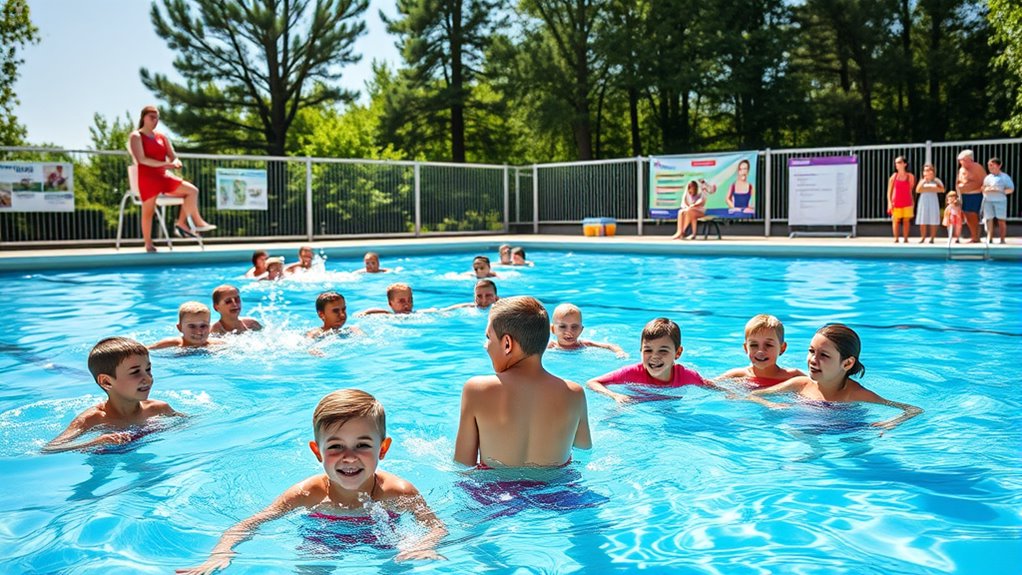
When it comes to ensuring kids’ safety around water, community resources play an essential role in providing education and skills. Local organizations partner with schools and recreational centers to offer free or low-cost swim lessons, making water safety accessible for all families.
Programs like the Red Cross’s Longfellow’s WHALE Tales engage young children through fun storytelling, while the YMCA’s Safety Around Water program teaches crucial skills like “Jump, Push, Turn, Grab.”
Many initiatives also provide CPR training and ongoing workshops, ensuring families stay informed. By integrating water safety into school curricula and promoting parental involvement, these resources help create a culture of safety, empowering communities to reduce drowning risks and foster lifelong skills in water competence. Additionally, understanding the importance of financial planning for assisted living can help families allocate resources for comprehensive safety programs.
Frequently Asked Questions
What Should I Do if a Child Goes Missing Near Water?
If a child goes missing near water, act quickly.
First, identify where they were last seen and gather details like their name and clothing. Notify lifeguards or authorities right away.
Start searching the area immediately, focusing on nearby water. Organize a search team and keep communication open.
If the child isn’t found quickly, escalate to emergency services.
Keep parents informed throughout the process, ensuring they stay involved and calm.
How Can I Teach My Child to Float?
To teach your child to float, start with the back float. Support their back and encourage relaxation by spreading their arms and legs. Gradually move your hands away until they can float independently.
Next, practice the front float by helping them put their face in the water and adopt a “starfish” position. Incorporate fun activities like games or songs to keep them engaged while reinforcing the importance of supervision and safety in the water.
Are There Age Limits for Specific Water Activities?
There aren’t strict age limits for most water activities, but height and coordination matter.
You’ll find that many water parks focus on these factors instead. For younger kids, activities like shallow pool play are great. As they get older, they can try more adventurous things, like slides or games.
Always check the specific rules at each location, and verify your child is ready for the challenges that come with each water activity.
What Signs Indicate a Child Is in Distress in Water?
When a child is in distress in water, watch for signs like arm waving or inability to call for help.
Look for their head being low in the water, with their mouth at or below the surface. If they seem unable to swim or float, that’s a clear indicator.
Also, notice if they’re gasping for air or show signs of extreme fatigue.
Always stay vigilant to guarantee their safety and well-being.
How Can Parents Encourage Safe Water Play Habits?
To encourage safe water play habits, you should designate a “water watcher” to supervise kids constantly.
Teach them never to enter water without an adult and discuss essential safety rules regularly.
Enroll them in swimming lessons to build confidence and skills.
Create a safe environment by securing water containers and ensuring safety equipment is available.
Finally, model safe behaviors and celebrate their progress, reinforcing the importance of balancing fun with safety.
Conclusion
Water safety isn’t just a theory; it’s an essential practice that can save lives. By staying vigilant and implementing the tips we’ve discussed, you can create a safer environment for your kids to enjoy their summer. Remember, constant supervision, proper safety measures, and teaching your children about water safety can make all the difference. Let’s keep our kids safe so they can make unforgettable memories this summer, all while having fun in the water!
